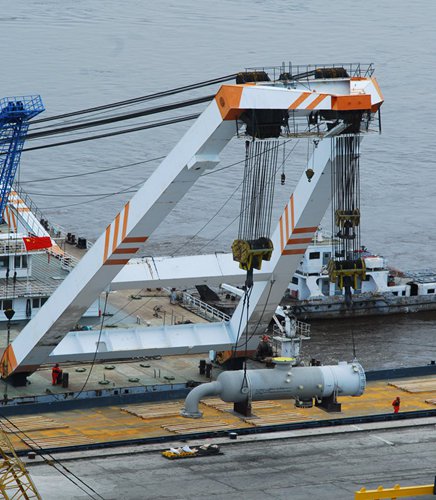HOME >> BUSINESS
China's increased gas imports from Russia could extinguish Australia’s LNG export rise
By Chu Daye Source:Global Times Published: 2019/7/17 18:38:40
Increased gas imports from Russia could extinguish Australia’s LNG exports

Natural gas equipment being shipped from Russia to China at a port in Heihe, Northeast China's Heilongjiang Province. File photo: VCG
The progress and functioning of Russia's Power of Siberia pipeline could be a bad omen for Australian liquefied natural gas (LNG) exports despite record volumes recorded in recent months.
Chinese state-owned oil major China National Petroleum Corp (CNPC) and Russia's Gazprom agreed on certain details about how a trans-border section of the pipeline should be put into operation, a statement on the CNPC website said on Tuesday.
On the same day, a top Gazprom executive said 2,156 kilometers of the Power of Siberia gas pipeline were already built, with 1,950 kilometers already tested.
Within China, construction is under way to bring Russian gas south to Shanghai, the nation's largest industrial city.
Jin Lei, an associate professor at the China University of Petroleum, pointed out that given a natural LNG cost disadvantage and Australia's strained ties with China, Australian LNG exports stand to lose from the upcoming era of Russian pipeline natural gas.
Australia has been China's largest source of imported LNG. In April, its shipments to China surged 61.3 percent year-on-year, as demand in China rose and Australia itself expanded its LNG export capacity.
"Australian LNG shipments to China will face a very big challenge when the Russian pipelines begin to channel gas," Jin told the Global Times on Wednesday.
LNG needs costly special-purpose vessels for transportation and the number of receiving facilities, which are also expensive, is limited in China, according to Jin.
"With this natural cost advantage over LNG, if the price of the Russia-China natural gas deal is reasonable, then pipeline gas will squeeze the LNG market," Jin said.
In 2014, Russia and China signed a $400 billion deal on the supply of 38 billion cubic meters of natural gas over a period of 30 years.
China is the world's top importer of natural gas and second-largest buyer of LNG after having surpassed South Korea in 2017.
A total of 46.92 million tons of natural gas were imported in the first half of this year, up 11.6 percent from one year earlier, data from the General Administration of Customs showed on Friday.
China's key sources for LNG are in Southeast Asia, Australia and Qatar.
For pipeline gas, China has currently two arteries channeling gas from Turkmenistan and Myanmar to feed its natural gas demand.
"The world's major consumption market for LNG is limited. With three pipelines in place and functioning, China's growing demand for natural gas can be met," Jin said.
Newspaper headline: Increased gas imports from Russia could extinguish Australia’s LNG exports
Posted in: INDUSTRIES,MARKETS